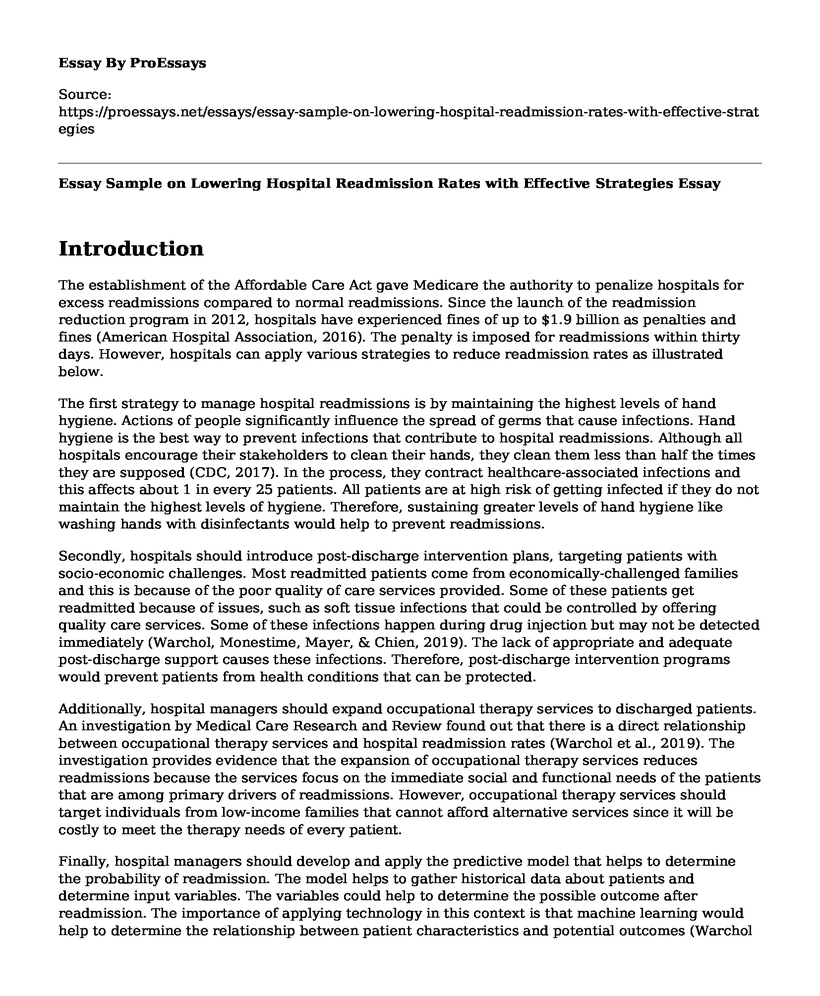Introduction
The establishment of the Affordable Care Act gave Medicare the authority to penalize hospitals for excess readmissions compared to normal readmissions. Since the launch of the readmission reduction program in 2012, hospitals have experienced fines of up to $1.9 billion as penalties and fines (American Hospital Association, 2016). The penalty is imposed for readmissions within thirty days. However, hospitals can apply various strategies to reduce readmission rates as illustrated below.
The first strategy to manage hospital readmissions is by maintaining the highest levels of hand hygiene. Actions of people significantly influence the spread of germs that cause infections. Hand hygiene is the best way to prevent infections that contribute to hospital readmissions. Although all hospitals encourage their stakeholders to clean their hands, they clean them less than half the times they are supposed (CDC, 2017). In the process, they contract healthcare-associated infections and this affects about 1 in every 25 patients. All patients are at high risk of getting infected if they do not maintain the highest levels of hygiene. Therefore, sustaining greater levels of hand hygiene like washing hands with disinfectants would help to prevent readmissions.
Secondly, hospitals should introduce post-discharge intervention plans, targeting patients with socio-economic challenges. Most readmitted patients come from economically-challenged families and this is because of the poor quality of care services provided. Some of these patients get readmitted because of issues, such as soft tissue infections that could be controlled by offering quality care services. Some of these infections happen during drug injection but may not be detected immediately (Warchol, Monestime, Mayer, & Chien, 2019). The lack of appropriate and adequate post-discharge support causes these infections. Therefore, post-discharge intervention programs would prevent patients from health conditions that can be protected.
Additionally, hospital managers should expand occupational therapy services to discharged patients. An investigation by Medical Care Research and Review found out that there is a direct relationship between occupational therapy services and hospital readmission rates (Warchol et al., 2019). The investigation provides evidence that the expansion of occupational therapy services reduces readmissions because the services focus on the immediate social and functional needs of the patients that are among primary drivers of readmissions. However, occupational therapy services should target individuals from low-income families that cannot afford alternative services since it will be costly to meet the therapy needs of every patient.
Finally, hospital managers should develop and apply the predictive model that helps to determine the probability of readmission. The model helps to gather historical data about patients and determine input variables. The variables could help to determine the possible outcome after readmission. The importance of applying technology in this context is that machine learning would help to determine the relationship between patient characteristics and potential outcomes (Warchol et al., 2019). Based on the relationship, medical practitioners can take appropriate actions to reduce negative results that would lead to readmissions. The primary role of the strategy is to assess readmission risk and potential strategies to overcome the problem. By implementing these policies, hospitals would prevent penalties since they will significantly reduce unnecessary hospital readmissions.
Conclusion
The Affordable Care Act introduced a readmission reduction program that focuses on reducing readmission rates within the first thirty days of discharge. Penalties on readmissions within thirty days are high; hence, hospital managers and medical teams should execute strategies to avoid drivers of readmissions. The proposed strategies include promoting hand hygiene, expand post-discharge intervention plans, and expand occupational therapy services and the application of the predictive model.
References
American Hospital Association. (2016). AHA Fact Sheet: Hospital readmissions reduction program. Retrieved from https://www.aha.org/factsheet/2016-01-18-aha-fact-sheet-hospital-readmissions-reduction-program
Warchol, S. J., Monestime, J. P., Mayer, R. W., & Chien, W. W. (2019). Strategies to Reduce Hospital Readmission Rates in a Non-Medicaid-Expansion State. Perspectives In Health Information Management, 16(Summer), 1a.
CDC. (2017). Clean Hands Count for Safe Healthcare. Retrieved from https://www.cdc.gov/features/handhygiene/index.html
Cite this page
Essay Sample on Lowering Hospital Readmission Rates with Effective Strategies. (2023, Apr 08). Retrieved from https://proessays.net/essays/essay-sample-on-lowering-hospital-readmission-rates-with-effective-strategies
If you are the original author of this essay and no longer wish to have it published on the ProEssays website, please click below to request its removal:
- Doctors on DNA, Cancer, Renal Failure and Differential Hierarchy Paper Example
- Essay Sample on Use of Medication to Treat Alcohol Dependence
- Assignment Example on Idea of a Healthy Community
- Research Paper on Use of Kruskal-Wallis in Dentistry
- Essay Example on Supreme Court Challenges Federal Regulation on Wetlands Isolation
- Essay Example on Nurses: The Heart of Healthcare Despite Scarce Resources
- Essay Sample on Professional Commitment: A Sense of Responsibility







